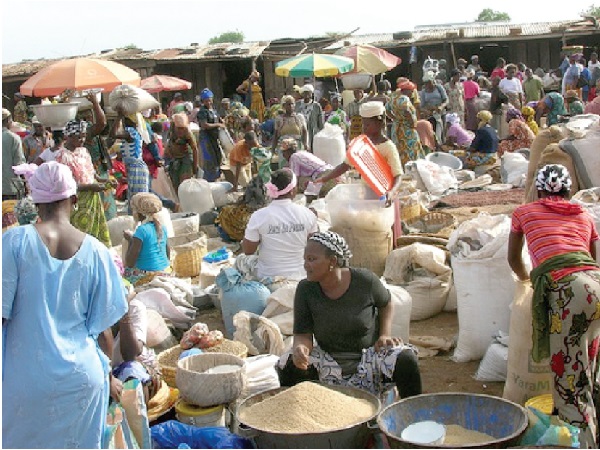Prices of major staple foods such as maize, millet and beans in the Eastern Region have moved up in the first two weeks of July 2021, following increases in transport fares.
The development has stimulated increases in the prices of various kinds of foods prepared with maize and beans.
Traders, largely women, who interacted with the Ghana News Agency (GNA) in a random survey conducted in the New Juaben South and Abuakwa South municipalities, have subsequently called for swift government intervention to help stabilise food prices.
The market survey at Juaben Serwa, Agatha, Koforidua Central and Kyebi markets showed that a maximum bag of maize is selling for GH¢600.00 while the mini bag is selling for GH¢350.00.
Madam Alice Ahenkorah, a maize seller, told the GNA that since January this year, the price of maize had seen a steady rise and attributed the recent increases to the marginal hike in transportation fares.
She said the price of a bag of maize hovered around GH¢450.00 from January to March while an olonka was sold at GH¢8.00. However, in May, the price rose from GH¢450.00 to GH¢480.00, with an olonka moving up to GH¢9.00.
Other traders blamed the upsurge on the high cost of farm inputs, including agrochemicals, a development which has forced farmers to adjust prices upwards to cover the cost.
Ms Mary Jonhson, a maize wholesaler who has been in the business for many years, explained how she procured maize through long travels sometimes from the Upper East Region, stressing that persistent fuel price increases were influencing transportation costs.
She said the retail maize prices had to go up to commensurate the farm gate price so that sellers could break even and stay in business.
Apart from transportation costs, she said maize farmers had increased their prices due to the rising cost of inputs.
Ms Philomina Ofori, a kenkey seller, said the price of maize had compelled her to either reduce her kenkey sizes or sell a ball at GH¢2.00 as against the previous price of GH¢1 or GH¢1.50.
Even with the GH¢2.00, she added, the size had to be reduced to be able to make a profit and cover costs of other items such as pepper, plastic carrier bags for wrapping kenkey, corn husk and firewood.
More observations
The survey also established that the prices of legumes were not different as a bag of beans was sold for between GH¢1,100.00 and GH¢1,180.00 and an olonka at between GH¢35.00 to GH¢40.00 on average, depending on the type of beans and quality.
Madam Haji Abubakari, a seller, said she got her supply from Techiman in the Bono East Region at prices ranging from GH¢1,120.00 to GH¢1,180.00.
At Kyebi in the Abuakwa South Municipality, buyers and sellers were equally worried about the hike in prices of rice, millet, maize, oats and wheat, and they blamed the increase on the onset of rains and new crop harvest season.
The prices had remained high in recent weeks as compared to last month due to the depletion of old stock.
Some traders have taken advantage of the situation and sharply increased prices, according to the market women as Ms Naana Yeboah, a maize seller, said a bag of maize that used to sell at GH¢200.00 was currently between GH¢320.00 and GH¢350.00.
She said many maize farmers in the local communities had not started planting because of the unpredicted rainfall pattern, adding that if the trend continued then there might be a shortage of maize this season.
Mrs Grace Osei, a trader, called for a uniform price for maize so that some traders would not capitalise on the shortage to dupe unsuspecting customers. She further appealed for market sheds for maize sellers at the Kyebi market.
Ms Zenabu Alhassan, a wheat and oats seller, said wheat was very affordable, unlike oats.
“A cup of wheat costs GH¢3.00 previously and is still sold at the same price,” she stated.
She blamed the price variations on transport charges, fuel increases and unpredictable rainfall.
The women called on the government to initiate actions that would ensure stable prices at the pump, standardise local food prices and regulate prices of farm inputs.
Speaking to the GNA on Thursday, Mr Edmond Quaynor, a feeds production farmer, corroborated the prices quoted by the traders and stressed that the cost of agrochemicals, labour and transportation had gone up.
He said maize bags were of different sizes as some weighed 150Kg and 50Kg and the price variations were understandable because areas where lands were being destroyed by illegal mining activities would likely record lower prices due to lack of market.
However, he said the prevailing market prices were good for farmers as they would stimulate high production and insisted the forces of demand and supply should be allowed to dictate the economic prices of food crops.
Source: Graphic Online





